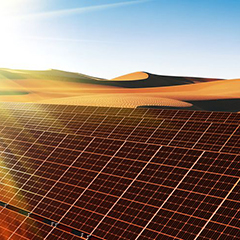Augsburg, July 11, 2016 – Hazy skies and dusty cars: Many people are well acquainted with the impact of the Saharan dust that travels to Europe by air. The impact of this dust – as haze in the atmosphere and as a residue on solar panels – on the performance of photovoltaic (PV) systems is being studied by the German Weather Service, the Karlsruhe Institute for Technology (KIT) and meteocontrol in a project called “PerduS.” The objective of the research is to facilitate better performance predictions for PV systems by improving projections about the dispersion of dust.
Saharan dust affects PV performance in two ways: First, the haze it creates, which can be substantial at times, can reduce performance by 10 percent to 20 percent. Second, it forms a residue on the PV modules that further impacts performance. These findings were reached during the preliminary studies conducted by the project partners. The term “blood rain” is frequently used when talking about the grimy layer left behind on cars following rain storms.
“During an outbreak of Saharan dust, atmospheric streams transport the dust whipped up by the Sahara over great distances that extend all the way to central Europe,” says Dr. Bernhard Vogel, a KIT meteorologist. “In terms of a long-range average, we see this four days a month in the spring and summer. In some years, the number even reaches up to nine days in a month.”
Photovoltaic systems generated 6 percent of gross electricity production in Germany during 2015, according to the German Statistical Office. The installed capacity of all PV systems totals about 39 gigawatts across Germany. As a result, the systems can produce peak yields of more than 30 gigawatts of power on clear days. This equals the production of more than 20 German nuclear power stations. Up to now, PV performance predictions have been unable to realistically factor in the effect of Saharan dust. The project team says this is necessary to ensure grid stability.
The German Ministry for Economic Affairs and Energy is funding the research project PerduS (a German acronym that stands for photovoltaic yield reduction caused by Saharan dust) for four years. The main objective is to combine all components necessary for consideration of Saharan dust outbreaks when projecting PV performance in a forecasting process. In cooperation with KIT, an improved dispersion forecast for desert dust is being added to the German Weather Service's numerical weather-forecasting model ICON. The ICON-ART forecast system will be used during future dust outbreaks along with the conventional numerical weather forecast. Simulating dust dispersion, the system will provide predictions about a reduction in solar irradiance. Drawing on this information, the forecast service provider meteocontrol will develop PV performance predictions as well as evaluate the technical and commercial use of the new forecasting system. In addition, an estimate will be made regarding the expected amount of residue on PV systems left behind by the Saharan dust and the cleansing effect on the units by subsequent rain storms.


























